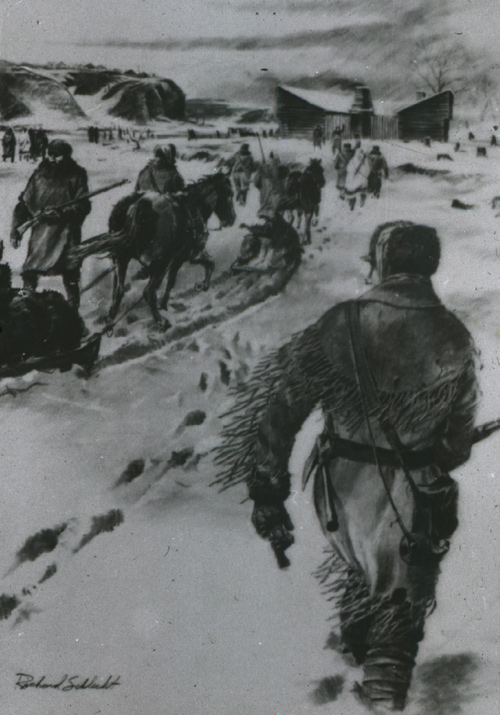At Fort Mandan below the Knife River Villages, blacksmiths shoe horses and three sleds are prepared to retrieve the harvest from Clark‘s hunt. Lewis is amazed that Mandan and Hidatsa horses prefer cottonwood bark over meal.
Shoeing Horses
ordered the Blacksmith to shoe the horses and some others to prepare some gears in order to send them down with three slays to join the hunting party and transport the meat which they may have pocured to this place—
—Meriwether Lewis
Cottonwood for Horses
Drewyer arrived with the horses about the same time, the horses appeared much fatieged I directed some meal brands given them moisened with a little water but to my astonishment found that they would not eat it but prefered the bark of the cotton wood which forms the principall article of food usually given them by their Indian masters in the winter season;
—William Clark
Ethnologist Gilbert Wilson provides more detail about sheltering and feeding horses during the winter:
Brought into the lodge, branches and bark were piled near the fire to thaw. About sunset, they were piled under the corral railing for the ponies to eat. The horses ate chiefly at night, but some of the fodder was saved for the morning.
. . . . .
The horses stood facing the fire as they fed. Twigs and smaller branches they ate readily; but limbs as thick as my wrist, they stripped of bark with their teeth. For this reason, the twigs and branchlets had been cut off and were piled by themselves. The thicker limbs, thus freed of branches, were more easily stripped by the ponies’ teeth.
. . . . .
We did not dare let our good horses stay out on the prairie at night, for enemies were frequently troublesome, and a foolish man might thus lose all his horses . . . .
We feed our horses no other kind of bark than cottonwood. It fattened the horses.[1]Gilbert L. Wilson, The Horse and the Dog in Hidatsa Culture, Anthropological Papers of the American Museum of Natural History, Vol. XV, Part II (New York: American Museum Press, 1924), 175–76, … Continue reading
Returning Hunters
A little after dark this evening Capt. Clark arrived with the hunting party— since they set out they have killed forty Deer, three buffaloe bulls, & sixteen Elk, most of them were so meager that they were unfit for uce,
—Meriwether Lewis
Hungry Wolves
the wolves also which are here extreemly numerous heped themselves to a considerable proportion of the hunt— if an anamal is killed and lyes only one night exposed to the wolves it is almost invariably devoured by them.
—Meriwether Lewis
Weather Diary
State of the Ther. at rise
Weather Wind at rise
Thermt. at 4 oCk. P.M. Weather Wind at 4 oCk. P.M. River 14 [below 0] fair S E 2 [above 0] fair W. Capt. Clark and party returned from hunting
—Meriwether Lewis[2]To assist the reader, the editor of this web page has omitted the date column, merged the “State of the River atrise” columns, and spelled out some abbreviations.
Experience the Lewis and Clark Trail
The Lewis and Clark Trail Experience—our sister site at lewisandclark.travel—connects the world to people and places on the Lewis and Clark Trail.
Plan a trip related to February 12, 1805:

Fort Mandan is a High Potential Historic Site along the Lewis and Clark National Historic Trail managed by the U.S. National Park Service. The North Dakota Department of Parks and Recreation manages a modern reconstruction and the Lewis and Clark Interpretive Center located at US Hwy 83 and ND Hwy 200A.
Knife River Indian Villages National Historic Site is a High Potential Historic Site along the Lewis and Clark National Historic Trail managed by the U.S. National Park Service. A unit of the National Park System, the site is located at 564 County Road 37, one-half mile north of Stanton, North Dakota. It has exhibits, trails, and a visitor center.
Notes
| ↑1 | Gilbert L. Wilson, The Horse and the Dog in Hidatsa Culture, Anthropological Papers of the American Museum of Natural History, Vol. XV, Part II (New York: American Museum Press, 1924), 175–76, archive.org/details/horsedoginhidats0015wils. |
|---|---|
| ↑2 | To assist the reader, the editor of this web page has omitted the date column, merged the “State of the River at  rise” columns, and spelled out some abbreviations. rise” columns, and spelled out some abbreviations. |



